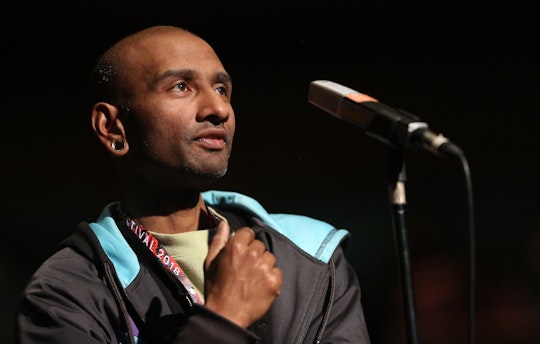‘A diaspora problem?’ Christopher Kulendran Thomas and Annika Kuhlmann’s Ground Zero and New Eelam
Sumugan Sivanesan
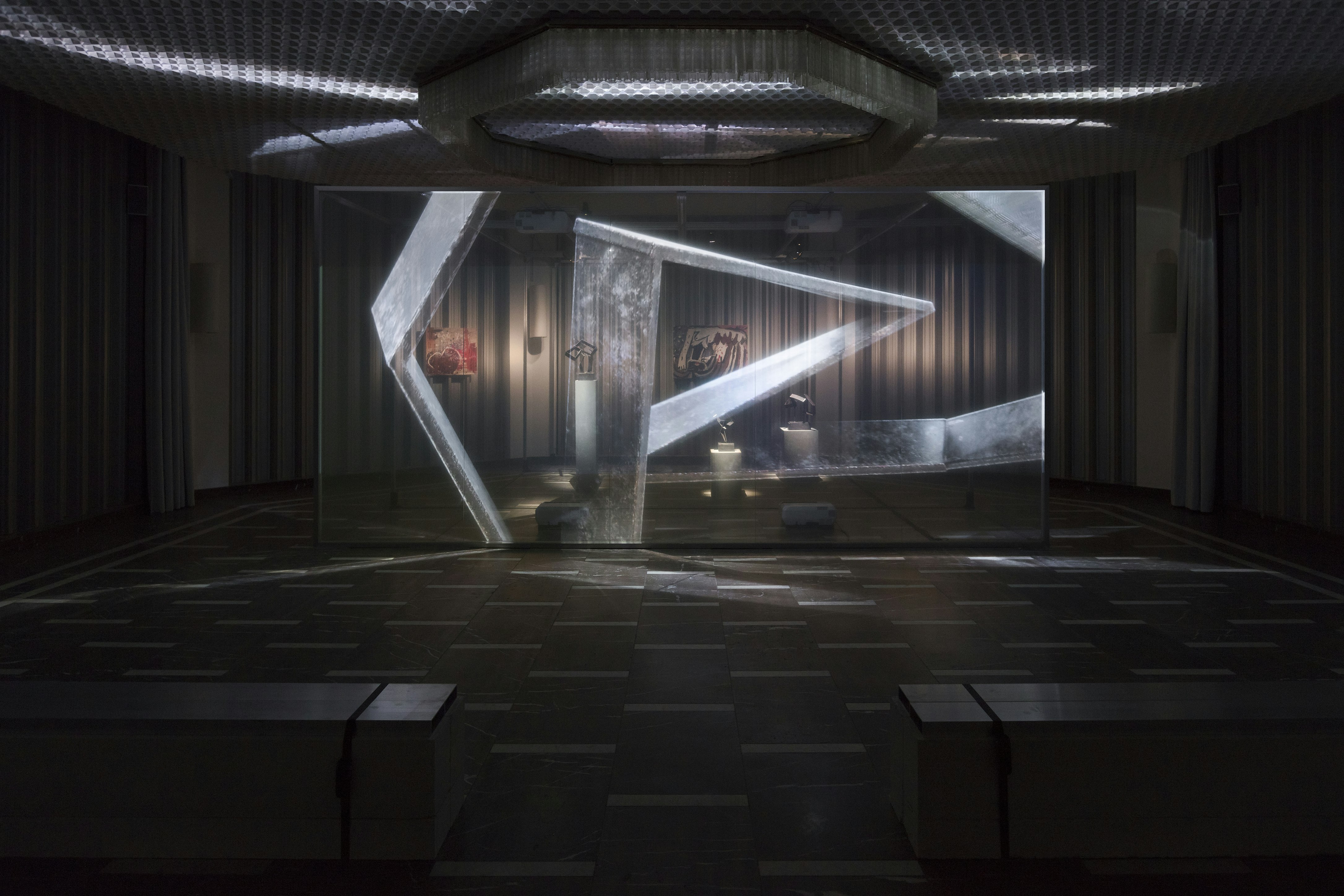
Christopher Kulendran Thomas in collaboration with Annika Kuhlmann, Being Human (installation view), 2019, digital projection on acrylic. Presented in Ground Zero, Schinkel Pavillon, Berlin, 11 September – 15 December 2019. Photo: Delfino Sisto Legnani and Marco Cappelletti. Commissioned by V–A–C Foundation. Courtesy Schinkel Pavillon.
Ground Zero (2019) is a slick and arresting spectacle by the young British-Tamil artist Christopher Kulendran Thomas in collaboration with Berlin-based curator Annika Kuhlmann. Opening during Berlin Art Week (11–15 September 2019), the installation has prompted much talk. The centrepiece of the exhibition is Being Human (2019), a twenty-minute thesis-video/scripted docu-fiction told through three figures: ‘a young Tamil artist’, ‘a famous popstar’ and ‘a well-known painter’. It plays on tropes of the artist interview, with its implications of the artist-as-genius in canonical Western art histories and as neoliberalism’s ideal subject, the creative entrepreneur.
Being Human puts forward a complex argument that draws on Thomas’ family’s involvement in the Tamil struggle for independence and the self-governed state of Eelam, in the north of Sri Lanka. Provoking a thirty-year civil war, the dream of Eelam was brutally quashed in May 2009 when Sri Lankan armed forces defeated the Liberation Tigers of Tamil Eelam (LTTE), killing between 40,000 and 100,000 Tamils. A decade on, Being Human addresses the failure of International Human Rights Law to bring justice for Tamils. Returning to concepts in European philosophy and Western art that gave rise to the idea of the universal human subject from which Human Rights Law is derived, the video questions the very category of the human in an era of algorithmic decision-making and networked governance.
Projected onto a semi-reflective glass box, the video installation forms a ‘three-dimensional hypertext’ that literally frames and stages artworks by artists Upali Ananda and Kingsley Gunatilake. Purchased from Saskia Fernando Gallery in Sri Lanka’s capital Colombo, these are installed behind the projection surface as an exhibition-within-an-exhibition. Periodically, the video image dissolves and white lights come on, illuminating the objects in a performative, and often lulzy, dialectical montage.
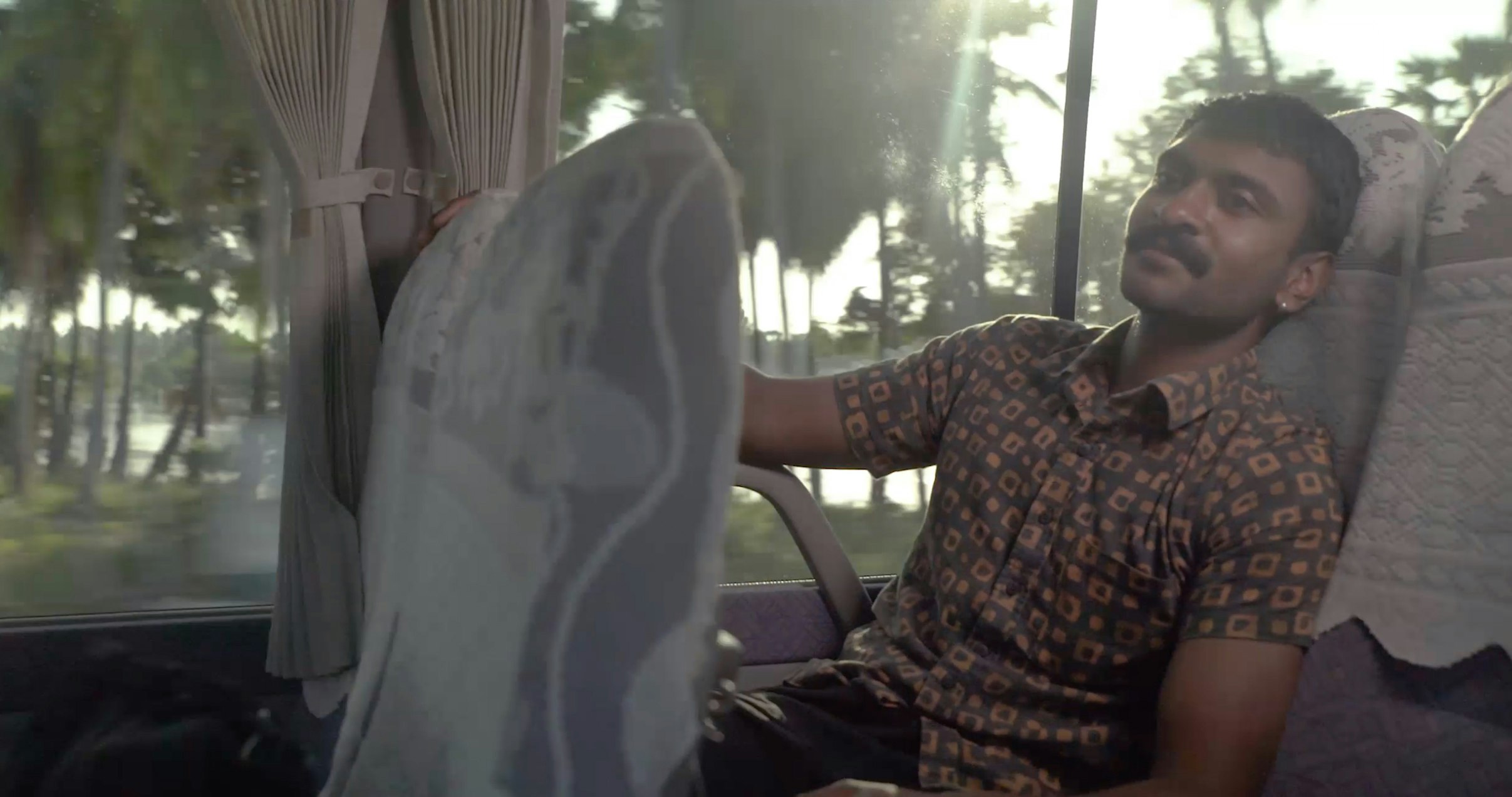
Christopher Kulendran Thomas in collaboration with Annika Kuhlmann, Being Human (still), 2020, digital video, commissioned by V–A–C Foundation, courtesy Schinkel Pavillon.
Art shapes the world
Being Human follows a young Tamil artist, performed by Oslo-based artist and designer Ilavenil Jayapalan, as he travels between the Colombo Art Biennale and the former Tamil capital of Jaffna in the north of the island. With a strong British accent (and styled in an enviable range of casual shirts), Jayapalan could well be a stand-in for Thomas as he delivers the latter’s thoughts straight to camera. Another character, a digitally generated ‘famous popstar’, looks uncannily like Taylor Swift, one of the world’s biggest selling recording artists, her face mapped onto the body of South African model Chantelle Pretorius. A third character, ‘a well-known painter’ (actor Peer Liening-Ewert, but I can’t tell if he is also digitally generated), is supposedly a guest of the Colombo Art Biennale. Colombo’s first Biennale took place in September 2009, just months after the end of the war, with the theme ‘Imagining Peace’, but seems to have been inactive since 2016. Being Human is also interspersed with segments of a video link conversation with Father Alphonsus Iruthayanayagam Bernard who founded the Centre for Human Rights in Tamil Eelam (Jaffna), and is described by Thomas in the exhibition notes as a family hero.
In one scene, a young Tamil artist sitting in the courtyard of a chic Colombo cafe asks:
Supposedly art created a space for this country to heal … a space for positional viewpoints, a space for new ideas, for freedom of thought … a space for democratic values. This is contemporary art and nowadays it is everywhere, but what exactly is it and how did it get here?
Thomas establishes a synergy between the end of the war in Sri Lanka and the appearance of contemporary art, linked to the country’s post-war economic prosperity and the failure of processes to hold accountable those responsible for human rights violations. He argues that contemporary art in Colombo lends a veneer of cosmopolitanism, civic culture and democracy to the authoritarian state, which claims to be an arbiter of justice having eliminated Tamils under the guise of defeating terrorism. As such, contemporary art smooths the entry of capital and investment by backers who also supported Sri Lankan forces, intensifying the economic discrepancies between the north and south of the island, and policies that reshape once majority Tamil areas. A young Tamil artist announces: ‘Every geopolitical issue is now negotiated as a human rights issue… Human rights is the medium by which imperial power is organised.’
For real
One of Ground Zero’s striking sequences is a dizzying montage of artwork details and white cube installation views, sourced from the web and fast cut to pulsing electronica. Later, a well-known painter comments on this meme-like proliferation of contemporary art ‘in an era of total connectedness.’ As explained by a young Tamil artist earlier, since Duchamp (Western) art has tasked the viewer with interpretation, contributing to the production of a privileged autonomous subject and affirming the theories of Emmanuel Kant of a universal human subject through whom the world can be known. Thus, a well-known painter claims that the circulation of contemporary art trains a collective performance through which a fiction of being human emerges. Regarding the nation state’s unwillingness to uphold human rights, a young Tamil artist poses the question:
Well, the idea of the individual upon which human rights is based derives from Kant’s definition of the universal human subject distinct from nature. Maybe the problem is not something that can be fixed within Human Rights International Law, maybe the problem is with the category of human itself?
In the following section a famous pop star discusses authenticity as a demand of the markets in which she operates. ‘I mean, I believe I’m genuine in what I’m doing, but that’s the paradox. So does everyone else.’ Appearing as a synthesised puppet, ‘Taylor Swift’ lists the way individuals perform their authentic selves on social media; posting their likes, meals, vacations, etc., as content from which data can be algorithmically analysed and repurposed, to in turn shape users’ behaviours. Arguably, a famous pop star’s observations about the entertainment industry are applicable across all of networked society when she states:
If believing in your own authenticity is the basic price of admission, then authenticity itself becomes the most contested object of synthesis … Behind the ranking algorithms and sociographs, maybe simulating simulated behaviour is the only way we have of being for real.
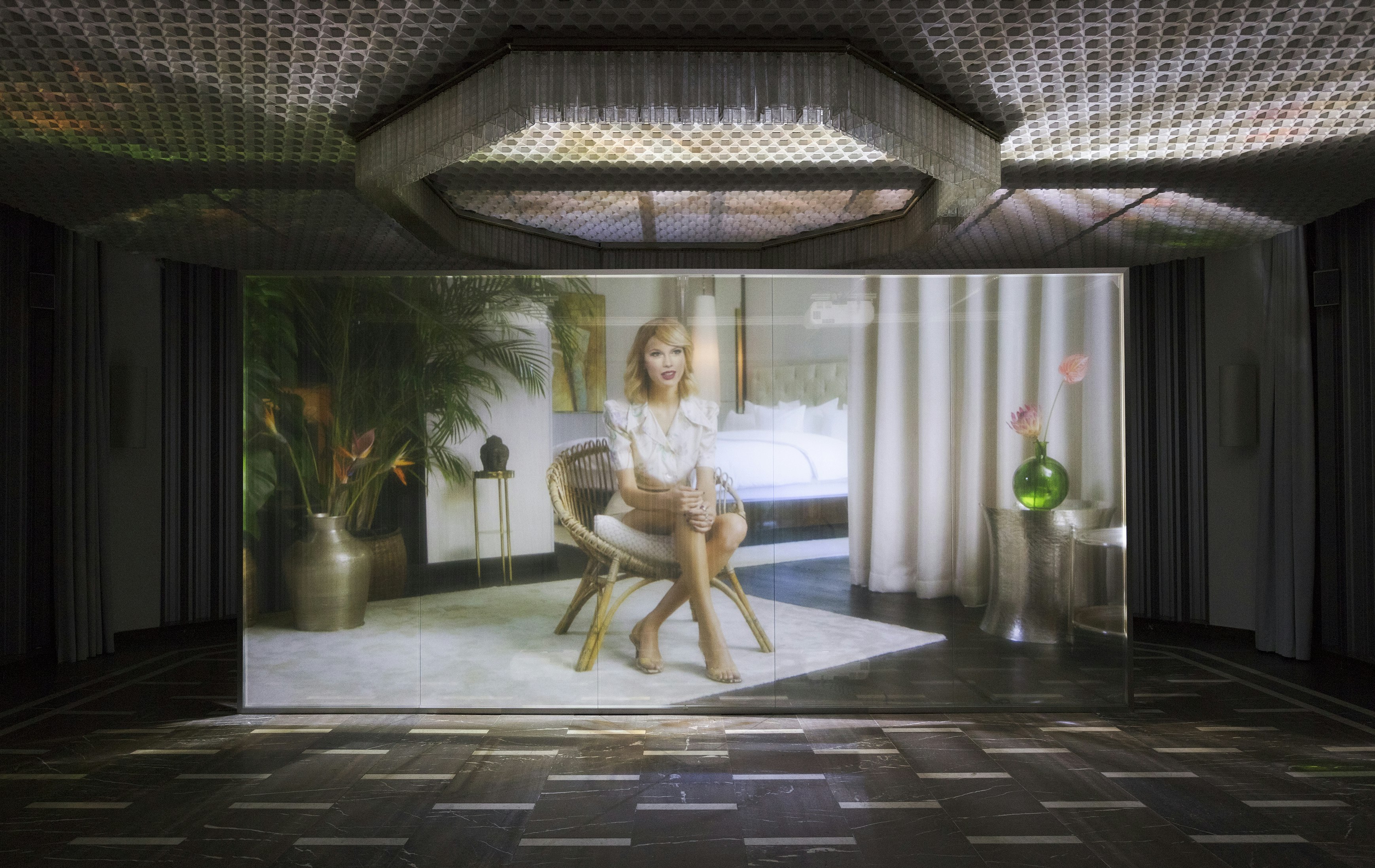
Christopher Kulendran Thomas in collaboration with Annika Kuhlmann, Being Human (still), 2020, digital projection on acrylic, Ground Zero, Schinkel Pavillon, Berlin, 11 September – 15 December 2019; photo: Delfino Sisto Legnani and Marco Cappelletti, commissioned by V–A–C Foundation, courtesy Schinkel Pavilion.
Propaganda
Being Human concludes by recalling a 2018 incident when angry Sinhala mobs attacked Muslims in the Sri Lankan district of Ampara, resulting in the death of 27-year-old Abdul Basith after his home was set on fire. The mob violence was prompted by the death of a Sinhala man following a traffic dispute with a group of Muslim youths (1). The text on screen reports that Facebook algorithms helped escalate this anti-Muslim rage. Irony gives way to propaganda.
For many in Tamil diasporas, these images of mob violence echo the 1983 anti-Tamil pogroms at the onset of the war. More broadly, it speaks of a long history of class and ethnic tensions on the island. One is also reminded of Tamil-Muslim prejudices and how the LTTE attempted their own ethnic cleansing in 1990 when they expelled Muslims from their homes with 24 hours’ notice. Many had lived alongside Tamils for generations (2).
My concerns with Thomas’ work is the way he appears to romanticise the struggle for Eelam. Arguably, the very notion of Eelam arose partly as a reactionary counter-myth to the ‘homeland’ nationalism developed by the Sinhala majority while the region was under British occupation and in the period prior to Lanka’s independence (3). While Ground Zero leaves aside the LTTE, who controlled the self-governed state under the autocratic leadership of Velupillai Prabhakaran, it is difficult to separate them from what constitutes Tamil self-determination. Indeed, Prabhakaran, who was killed in 2009 during the final battle at Nanthikadal, is still revered by many in the diasporas. So while I support the need to denounce Sinhala supremacy and demand post-war justice, I wonder if Thomas’ ideas, forged in the diasporas, speak to the people of the north and east, Tamils and other minorities.
Power
Since the launch of his 2012 artistic enterprise When Platitudes Become Form, Thomas, a Goldsmiths (University of London) graduate, has been buying the works of promising Sri Lankan contemporary artists and ‘reconfiguring’ them for sale in the art scenes in which he circulates. For Ground Zero, works by Upali Ananda and Kingsley Gunatillake made in 2018 are subtly retitled with the year of Thomas and Kuhlmann’s 2019 installation. Displayed intact, they are nevertheless most visible in the galleries and museums of the global north as their possessions.
It was revealing that when I visited Sri Lanka at the end of 2014 and asked both young and established artists if they were aware of Thomas’ work, I was met with silence and (feigned?) disinterest. Indeed, Thomas may well be a significant collector of contemporary Sri Lankan art. While the artists I spoke with—Tamil, Sinhalese and otherwise—struggle to raise interest in international art markets and make a living from their practice, Thomas is able to access excessive funds and supporters. It is notable that Ground Zero was commissioned by the Russian V-A-C Foundation for the 58th Venice Biennale and has an impressive list of production credits. Thus, Ground Zero can be read as a display of art power that might affirm ideas about diaspora privilege and the meddling of Western-educated intellectuals that irritates many on the island struggling for peace. As Thomas considers spectatorship a material to be worked with, his art spectacles make viewers (and indeed this reviewer) complicit in developing Thomas’ art power as a brand.
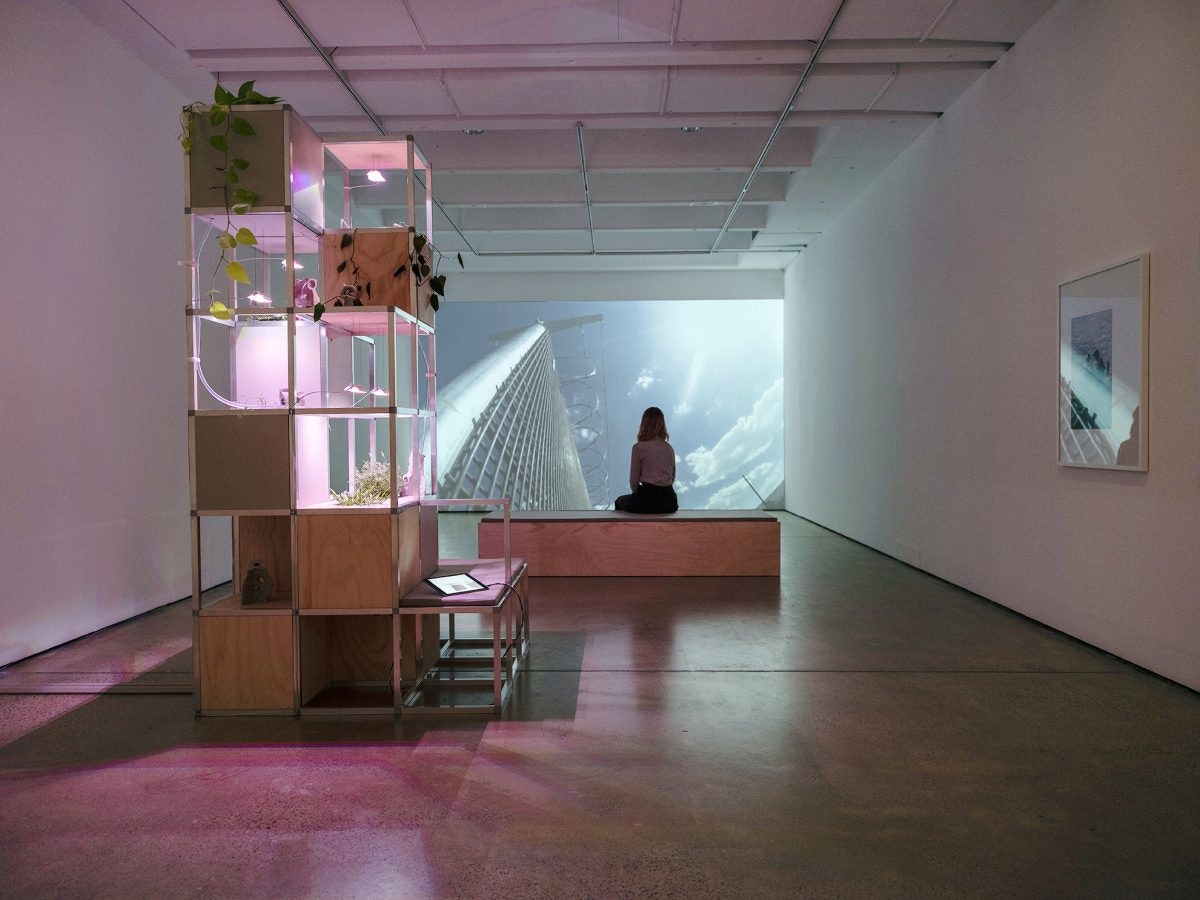
Christopher Kulendran Thomas in collaboration with Annika Kuhlmann, New Eelam: Brisbane (installation view), Institute of Modern Art, Brisbane, 2019. In view: NE_HYDRO_07 (2019), aluminium, plywood, steel, silicone, latex, water, pump, clay, grow lights, various plants, 124 x 124 x 245.5 cm; 60 million Americans can’t be wrong (2018), HD video, 00:27:15. Commissioned by the IMA, A Tale of a Tub, DIS, and Tensta konsthall. Photo: Carl Warner.
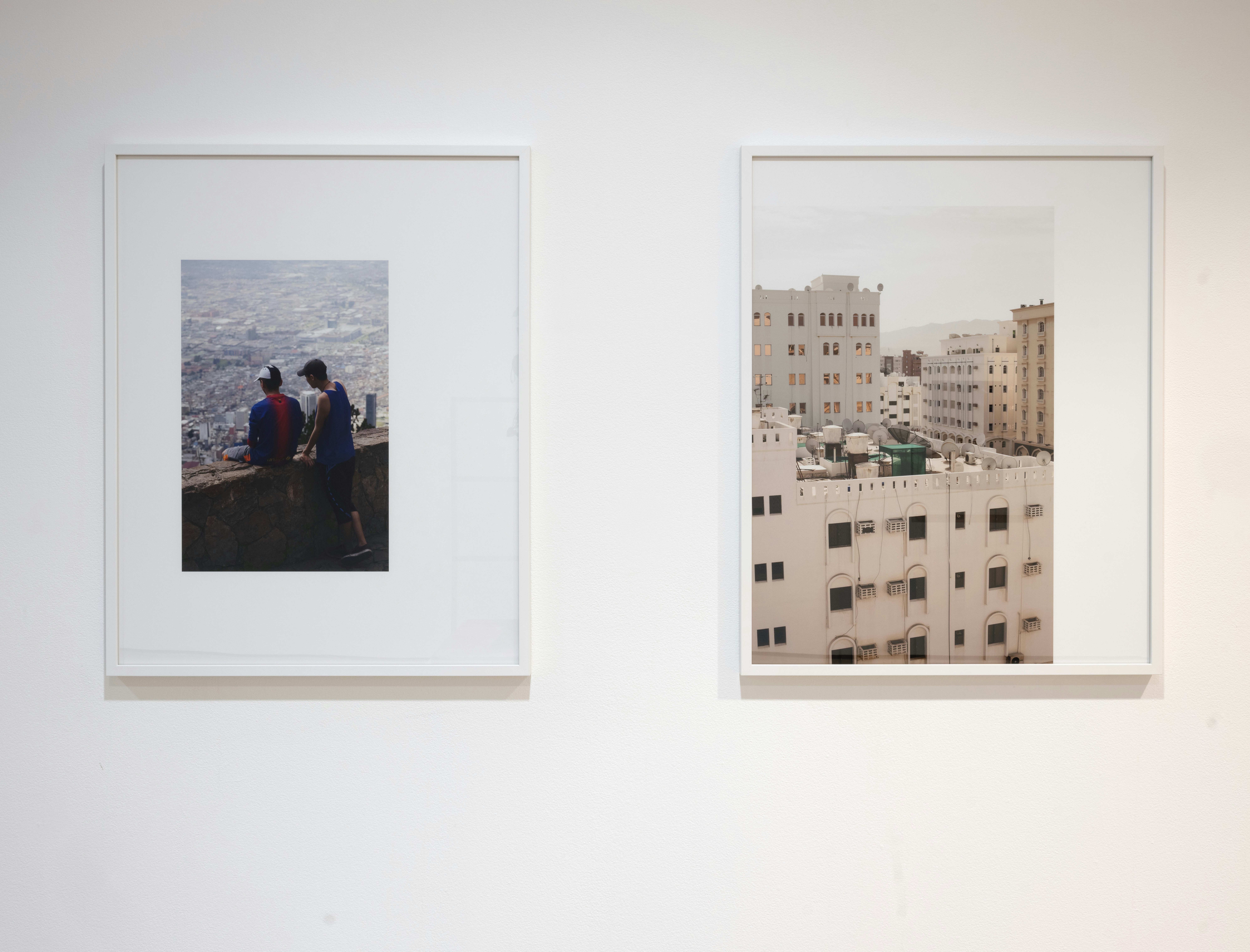
Christopher Kulendran Thomas in collaboration with Annika Kuhlmann, New Eelam: Brisbane (installation view), Institute of Modern Art, Brisbane, 2019. In view: NE_P_07, 2019, archival inkjet print, 80 x 100 cm; NE_P_08, 2019, archival inkjet print, 80 x 100 cm; photo: Carl Warner.
Home
Thus, it is worth contextualising Ground Zero with Thomas and Kulhmann’s other enterprise, a real-estate technology start-up, New Eelam, first exhibited at the 9th Berlin Biennale, 2016, curated by New York-based collective DIS, and more recently at the Institute of Modern Art, Brisbane, 2019. ‘Eelam’ loosely translates as ‘home’ in Tamil, and New Eelam was founded to develop an idea of flat-rate subscription housing, similar to how Netflix and Spotify stream movies and music, to cater for a mobile and flexible ‘post-work’ society liberated by automation. As described in the artists’ (corporate) video 60 million Americans can’t be wrong (2017), the proposed ‘housing cloud’ would maximise profits by trading its portfolio of flexibly-occupied apartments. Capital gains absorbed by the start-up would go towards reducing the subscription price rather than return as dividends to shareholders, making its housing/lifestyle model more accessible and desirable.
If this phenomena develops it could give rise to ‘cloud nations’ (similar to how Facebook users might be considered a population) which forms the basis of what Thomas and Kuhlmann describe in 60 million Americans can’t be wrong as ‘liquid citizenship’, a form of citizenship based on self-selected networked ‘autonomous individuals’ with common interests rather than by geographically-bounded nation states. From such ‘reverse diasporas’ inhabiting New Eelam, there would emerge a form of self-governance based on common desires managed by technology, rather than by the militarised force that organised the semi-autonomous state that inspired it.
Arguably, New Eelam sets up a process to discover what democratic forms might emerge in accelerated technocapitalism. Yet, behind its smooth rhetoric New Eelam seems similar to the kinds of entrepreneurial co-housing schemes designed for aspiring millennials that are set to expel socially and economically marginalised communities from already gentrified cities. Such initiatives are stirring debates in Berlin, where Thomas and Kuhlmann sometimes live (4), and indeed Kuhlmann admits that New Eelam:
… will provide no immediate solution to the urgent problems of displacement or of those excluded from citizenship, on a longer timescale, we’re interested in how dislocation is perhaps becoming a permanent condition for more and more people (5).
Thomas and Kuhlmann have produced a thought provoking project that is troubling because of its persuasiveness. Abandoning hampered discussions about art as a means towards global civic culture, they are initiating what sounds like an alternative privatised takeover of civil society (6). Will it produce, as they propose, a form of automated ‘luxury communalism’ based on what users really want or give rise to what Métis artist and scholar Audrey Samson (7) fears as a ‘deeply hierarchical citizenry model governed by market operations’? Given time, New Eelam may prove to be more than just a diaspora problem.
Notes
(1) Mujib Mashal and Dharisha Bastians, ‘Sri Lanka Declares State of Emergency After Mob Attacks on Muslims’, The New York Times, 6 March 2018.
(2) Suvendrini Perera, ‘Sri Lanka: Landscapes of Massacre,’ in Torture: Power, Democracy and the Human Body. Eds. Shampa Biswas and Zahi Zalloua (Seattle and London: University of Washington Press, 2011), 215–243.
(3) Arjun Guneratne, ‘What’s in a name? Aryans and Dravidians in the Making of Sri Lankan Identities,’ in The Hybrid Island: Culture Crossings and the Invention of Identity in Sri Lanka, ed, Neluka Silva (London: Zed Books 2002), 20–40.
(4) Kim Sonntag, ‘Open Letter by KUNSTBLOCK AND BEYOND for the protection of the non-commercial youth centres Potse and Drugstore’, 14 December 2018.
(5) Christopher Kulendran Thomas and Annika Kuhlmann, New Eelam: Tensta (2017, exhibition guide PDF), 10.
(6) Christopher Kulendran Thomas, ‘ART & COMMERCE: Ecology Beyond Spectatorship’, DIS, 7 March 2014.
(7) Martha Barratt, Martha and Audrey Samson, ‘New Eelam,’ Burlington Contemporary, 20 March 2019.
About the contributor
Sumugan Sivanesan is a writer, researcher and artist.
